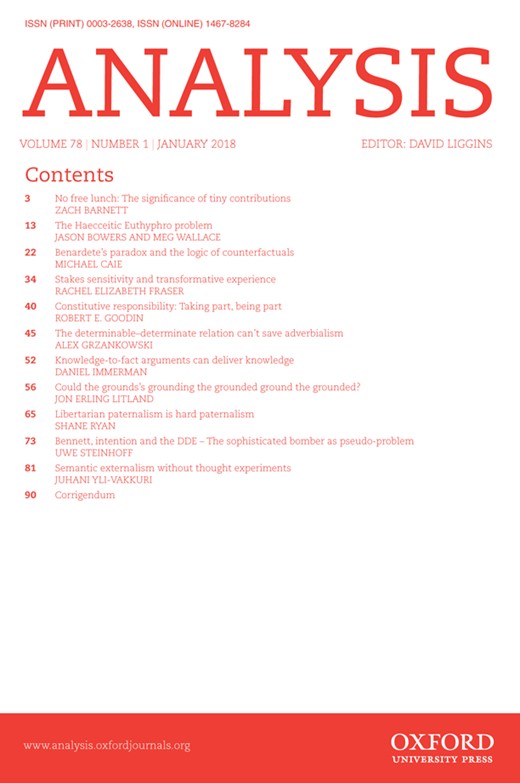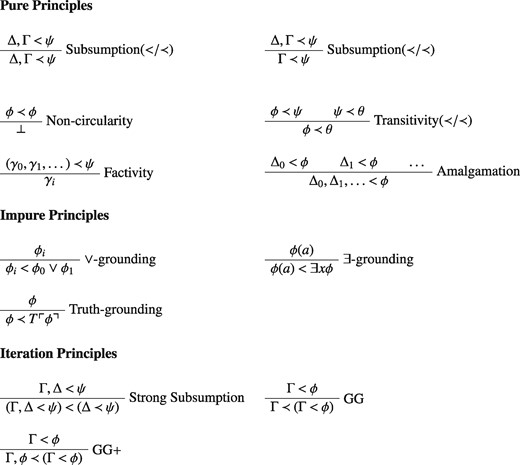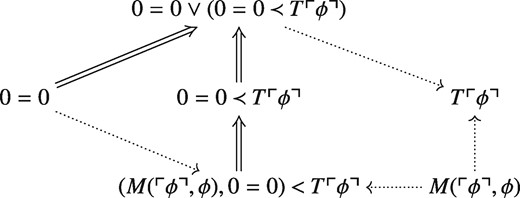-
PDF
- Split View
-
Views
-
Cite
Cite
Jon Erling Litland, Could the grounds’s grounding the grounded ground the grounded?, Analysis, Volume 78, Issue 1, January 2018, Pages 56–65, https://doi.org/10.1093/analys/anx116
Close - Share Icon Share
Abstract
Could ’s partially grounding itself be a partial ground for ? I show that it follows from commonly accepted principles in the logic of ground that this sometimes happens. It also follows from commonly accepted principles that this never happens. I show that this inconsistency turns on different principles than the puzzles of ground already discussed in the literature, and I propose a way of resolving the inconsistency.
Could the grounds’s grounding the grounded ground the grounded?
The answer to the opening question is ‘yes’: it follows from standard principles in the logic of ground that that there are facts and such that ’s partially grounding partially grounds . This might seem like a mere curiosity, but it has important consequences for the following hotly debated issue. Suppose that the fact grounds the fact ; then this – that grounds – is a further fact, and we may ask what grounds it. (This is the Problem of Grounding Ground.) Most philosophers who have addressed it have held that is at least a partial ground for ’s grounding . Unfortunately, this, together with standard principles in the logic of ground, entails that the answer to the opening question is ‘no’. Standard and plausible principles about ground are thus inconsistent; moreover, this inconsistency turns on different principles than the inconsistencies unearthed by Fine (2010) and Krämer (2013). In particular, the principle of Amalgamation – that if each of and is a ground for then together with is a ground for – plays a role in generating the inconsistency.
In this article, I establish the above claims and, tentatively, argue that we resolve the inconsistency by giving up Amalgamation, thus clearing the way for ’s grounding ’s grounding .
1. Principles of ground
As usual, we distinguish between full and partial ground. We use as a sentential operator for full ground;1 and as a sentential operator for partial ground. If is some collection of sentences and is a sentence, then and are sentences.2 With this symbolism in place the opening question can be stated more precisely: are there some cases where we have and in addition ?
The discussion revolves around the principles depicted in Figure 1. The principles come in three types. The pure principles govern the interaction of full and partial ground, abstracting away from the logical complexity of the grounds and the grounded. The impure principles tell us what grounds logically complex groundeds. The iteration principles provide partial answers to the problem of grounding ground. Let me briefly discuss the motivation for these principles, beginning with the pure principles.3
Following orthodoxy, I take the basic notion to be full ground, which I take to be an explanatory notion.4 If , then provides a full explanation of – nothing needs be added to to provide a full explanation of . We take partial ground to be defined in terms of full ground in the sense that the partial grounding claim is the existentially quantified claim: there is some such that . This justifies Subsumption(): every instance of full ground is an instance of partial ground. It also justifies Subsumption().
Throughout we assume that ground is factive in the sense that if then each as well as is the case. We also take partial ground to be transitive. This follows from full ground satisfying the following principle: 
That principle, in turn, is justified by the thought that if fully explains , and together with fully explains , then we can chain these explanations together to show that together explain .5 We also assume Non-circularity: no partially grounds itself. The more contentious principle here is the principle of Amalgamation, which says that if each of the is a full ground for , then the taken together fully ground . It is widely held that ground is non-monotonic: from one cannot conclude that . One might think of Amalgamation as a restricted monotonicity principle: if grounds , then grounds as long as also grounds .
Turning to the impure principles, we assume that if it is the case that , and is a name for the sentence , then partially grounds that is true. This reflects the intuition that it is because things are thus-and-so that any sentence that says that things are thus-and-so is true. The principles of -grounding and -grounding try to capture the idea that disjunctions and existential generalizations cannot simply be true but must derive their truth from the truth of the disjuncts or instances.
The iteration principles provide partial answers to the problem of grounding ground. Strong Subsumption is justified by our taking partial ground to be defined in terms of full ground. Strong Subsumption is then a special case of the thought that an existential generalization is grounded by its instances.
If Strong Subsumption is right, then the central question is what grounds that . While there is no consensus, all the existing views on grounding ground have held that is part of a full ground for .6 This gives us the principle labelled GG.7 A variant of GG holds that not only but also is a partial ground for . This is the principle GG+.8
2. Results
We are finally in a position to state the results.
Assume Strong Subsumption and GG. Then for no do we have .
Suppose otherwise. By the definition of partial ground there is such that . Strong Subsumption then gives us . By GG we get . Transitivity, Subsumption(), and Subsumption() gives us , contradicting Non-circularity.
Assume Strong Subsumption, GG, and Amalgamation. Then for no and do we have .
Suppose that . By definition of partial ground there is such that . By Factivity and so, by definition of partial ground, there is such that . By Amalgamation, . By Subsumption() and Subsumption() we get . This contradicts Proposition (2.1.).
Assume GG+ and Strong Subsumption. Then for no do we have .
Suppose . Then by Factivity , and so, by the definition of partial ground, there is such that . By GG+ we get that . By Strong Subsumption and Subsumption() we get . Transitivity and Subsumption() gives us . Another application of Transitivity gives us contradicting Non-circularity.
3. The construction
4. Possible responses
We have shown that the principles in Figure 1 are inconsistent. Which principles should we give up?
I believe that the choice is between the applications of -grounding and -grounding, on the one hand, and Amalgamation and GG+, on the other. But I should note that every one of the principles in Figure 1 has been questioned in some context or other, and while I cannot discuss every principle I should at least say why I do not think that giving up either Transitivity or Non-circularity gets to the heart of the matter.11
The problem with giving up Transitivity is that even if one follows Schaffer (2012) and rejects transitivity in general, giving up the present applications of transitivity does not seem plausible. In Schaffer’s counterexamples, we have chains of ground where relevance seems to fail to transmit from the beginning of the chain to its end. But in the present cases, there does not appear to be any failure of relevance-transmission.
When faced with self-referential constructions many have been tempted to give up Non-circularity.12 I do not believe that this solves the core puzzle. First, of all the principles governing ground, Non-circularity seems to me the most central. Second, and more importantly, even if there is a notion of ground that fails to satisfy Non-circularity, Fine (2010: 105) and Litland (2015: 498–501) have shown how one can introduce a natural notion of ground that, by definition, satisfies Non-circularity. The principles in Figure 1 appear plausible for that notion of ground, too, and so the puzzle remains.
If the choice is between Amalgamation and GG+, on the one hand, and -grounding and sentential -grounding on the other, one might think that it is clear that we should give up -grounding and sentential -grounding. Did not Fine (2010) already observe that the principle of -grounding is not generally valid? And did not Krämer (2013) already observe that sentential -grounding is not generally valid?
Let us focus on -grounding. I agree that -grounding is not valid, but I do not think that the invalidity of -grounding settles the issue. Some applications of -grounding are acceptable – there is, e.g., nothing wrong with concluding that . Could all the applications of -grounding used in §3 be acceptable? To settle this we need a systematic account of which applications of -grounding are acceptable.
I believe the correct account is the following. Applications of -grounding and -grounding are ‘innocent until proven guilty’: if accepting the applications does not generate cycles of ground, they should be accepted.13 A defence of this account lies outside the scope of this article, but a point in its favor is that it allows us to retain as many applications of the intuitively plausible principles in Figure 1 as we consistently can. What matters for our purposes here is that as long as the applications of -grounding we relied on in §3 do not lead to cycles of ground we can consistently accept them and so be free to accept that .
If we retain Amalgamation or GG+, we know from Propositions (2.2.) and (2.3.) that we do get cycles. But it turns out that if we reject both Amalgamation and GG+ then the applications of -grounding do not lead to cycles. The easiest way of seeing this is to consider Figure 2, which depicts the grounding structure given in the construction in § 3. The diagram is to be read as follows. A double arrow represents immediate full ground. A dotted arrow represents partial ground. expresses that the sentence means that . plays two roles. First, the fact the sentence means together with its being the case that is what fully grounds . Second, spelling out GG in somewhat more detail, we hold that since together with are the full grounds for they are also the full grounds for .14
This just shows that we can retain the relevant applications of -grounding at the cost of giving up Amalgamation and GG+. Should we? I will tentatively suggest that we should, and that we therefore must answer the opening question in the affirmative. But in case the following argument does not persuade, let me state what I take to be the more secure conclusion of the paper.
While the Problem of Grounding Ground is no doubt important it is tempting to think that one can settle what the correct pure and impure principles of ground are without solving the Problem of Grounding Ground. In particular, one might have thought that one could settle whether Amalgamation is valid without getting into the Problem of Grounding Ground – Amalgamation, after all, does not concern what grounds facts about ground. The above results show that this is wrong: natural views on what grounds ground directly affect which pure and impure principles one can accept.
It is not clear what the motivation for GG+ is. All the proposed solutions to the Problem of Grounding Ground naturally motivate GG but not GG+. To take but one example, Bennett holds that ground is a ‘superinternal’ relation in the sense that the obtaining of the grounds bring about not just the obtaining of the grounded but also the obtaining of the grounding relation between the grounds and the grounded. This clearly motivates GG but not GG+. None of this is to say that GG+ could not be motivated, it is just to point out that it has not yet been motivated.
Its importance in the Pure Logic of Ground (Fine 2012b) notwithstanding I believe we have independent reason for rejecting Amalgamation. It seems natural to think that we can introduce operators by specifying what the grounds for propositions formed using those operators are. The specification of the grounds gives the essence of the operator. The essence of conjunction, e.g., is given by specifying that the (immediate) grounds for a conjunctive proposition are the conjuncts. If this is possible it should be possible to introduce a disjunction operator that is grounded in each of its (true) disjuncts, but not in both of them taken together. If this is right, then Amalgamation does not hold in general. What is important for present purposes is that we can always insist that in the above construction the disjunction operators are non-amalgamating. If the construction is understood in that way, then there are no cycles and there is no obstacle to allowing .
It is true that if we can introduce a non-amalgamating disjunction operator in this way then we should also be able to introduce an amalgamating one. If the example in § 3 is formulated with such an amalgamating disjunction operator, we have to reject the relevant instance of -grounding on pain of generating cycles of ground. But that the example does not work when formulated with an amalgamating disjunction operator does not mean that it does not work when formulated with a non-amalgamating one.
A way of blocking this argument would be to hold that it is in the nature of ground to be amalgamating. Then the nature of disjunction would ensure that each of the disjuncts was a ground, and the nature of ground would take over to guarantee that they together were grounds. One cannot reject that there is such an amalgamating notion of ground. For let be any notion of ground. Then we can define by saying that iff and for each we have . is, by definition, an amalgamating notion of ground (cf. Correia 2014: §2.F).
It seems to me, however, that it is the non-amalgamating notion that is basic and that the amalgamating notion is defined in terms of it. This viewpoint gains some support from the fact that in both the truthmaker semantics (e.g., Fine 2012b) and the graph theoretic semantics (e.g., deRosset 2015) extra conditions have to be imposed to ensure that we end up with an amalgamating notion of ground.
If this is right, then we must reject Amalgamation (at least for the basic notion of ground). We can conclude that the grounds’s grounding the grounded can ground the grounded.15
Footnotes
1 While we officially express claims of ground using a sentential operator, for reason of readability we freely talk as if ground were a relation between facts. If one thinks that ground is a relation between facts, one can easily rephrase the discussion.
2 Note that unlike Fine (2012b), we allow many sentences on the left of partial grounding claims. Having such a notion of partial ground allows us to express that partially ground , something we cannot express using Fine’s notion. (I suspect Fine worked with a more restricted notion of partial ground for technical reasons: if one inspects the completeness proof in Fine 2012b one sees that it relies on working with the restricted notion).
3 Each of these principles has been questioned, but it is fair to say that they represent the orthodox view. We consider whether some of the principles should be given up later.
4 We do not need to settle here whether ground itself is an explanatory notion – as Fine (2012a) and Dasgupta (2014) hold – or whether it rather ‘underwrites’ or ‘backs’ explanation – as Schaffer (2012) and Audi (2012) hold.
5 Transitivity has been challenged by Schaffer (2012). We discuss this briefly in § 4.
6 Litland (2017), deRosset (2013) and Bennett (2011) hold that is in fact a full ground for ; Dasgupta (2014) and Rosen (2010) hold that is a merely partial ground and that to get a full ground we need some fact about essence. Loss (2015) argues compellingly that any view of grounding ground must validate GG – at least for the cases where each is ungrounded.
7 It is to be able to express GG properly that we allow many sentences on the left of the ≺-operator. Thanks to an anonymous reviewer on this point.
8 As far as I know the only philosopher who has suggested this view is Raven (2009).
9 In his unpublished paper ‘The explanatory character of moral principles’ (n.d.) Selim Berker also presents a case of the grounds’s grounding the grounded grounding the grounded. His case differs significantly from the one presented here.
10 Here is a way in which such self-reference could come about. Suppose that the unique sentence with label is the sentence: ‘0=0 or 0=0 partially grounds that the unique sentence with label is true’.
11 Let me mention two other approaches: deRosset, in his unpublished “The metaphysical transparency of truth”, gives up the idea that disjunctions can be grounds and Korbmacher (2017) develops a predicativist approach, replacing the untyped Truth-grounding principle with a hierarchy of typed Truth-grounding principles.
12 This strategy has recently been developed in detail by Woods (forthcoming).
13 For systematic development of this approach, see Litland 2015.
14 This is the version of GG defended by Bennett, deRosset and Litland. The version defended by Dasgupta and Rosen adds in addition an essentialist fact, but this will not introduce any cycles.
15 Thanks to Selim Berker for first prompting me to think about these issues. Thanks also to Justin Morton and Ray Buchanan for discussion. Special thanks is due to two anonymous referees for Analysis whose perceptive comments greatly improved the article.





